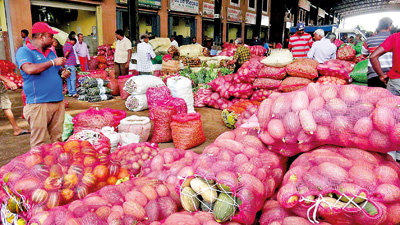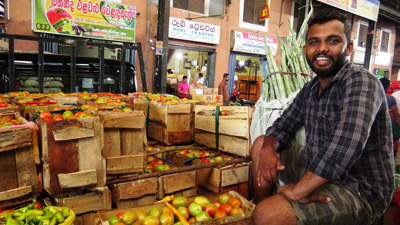News
Dambulla merry-go-round makes jaws drop on veggie prices
Soaring vegetable prices caught President Gotabaya Rajapaksa’s attention this week, following the public outcry against middlemen who are profiting, while consumers and farmers struggle.

Vegetables from Jaffna at the Dambulla Economic centre. Pix by Kanchana Kumara
President Rajapaksa instructed officials of Mahaweli Development and the Ministry of Trade to control the prices.
Officials briefed the President that vegetables brought to Dambulla Economic Centre are weighed, priced, and then distributed at additional cost, including transport.
The President noted the situation was unacceptable and although economic centres had been set up to provide relief to consumers and small traders, issues have arisen as these centres are now controlled by large-scale traders with vested interests.
During the meeting, attention was also drawn to exploring the possibilities of vegetable cultivation in state lands belonging to plantation companies, the Presidential Secretariat, said.
According to the Census and Statistics Department’s weekly average retail price list, vegetable prices have fallen slightly. However, in comparison with the last week of February last year, the prices are high.
A kilo of pumpkin sells for Rs. 258, compared with Rs 92 in February last year. Snake gourd costs Rs. 208 compared with Rs 141 last year.
A kilo of green beans was Rs 157 rupees last year and is now sold at Rs 278.
Bitter gourd that was sold at Rs 195 rupees per kilo in February last year, is now sold at Rs. 243, a slight drop from last week’s Rs 265.
Carrot dropped from last week’s Rs 412 rupees a kilo to Rs 289. However, the price remains high compared with Rs 157 in February last year. Long beans that was Rs 142 per kilo last year is now sold at Rs 215 per kilo. Coconuts cost between Rs 60 and Rs 90.
Vegetable vendor, L. W. Sugath, said vegetable prices went up to Rs 500-Rs 600 per kilo last month. Prices of fish and coconut have risen.
“The drop in vegetable prices is small, and people are still reluctant to buy,’’ he said. 
A kilo of tomato that was Rs 112 in February last year, sells at Rs 304, down by about Rs 100 from last week’s Rs 400. Garlic is sold at Rs 580 a kilo, compared with last February’s Rs 269. Last week, garlic was Rs 567.
Red onion still remains a pricey commodity this week as well, at Rs 437 a kilo. Last year, red onions were sold at Rs 177 a kilo.
M. Anees, a father of three, said he buys vegetables for a few days at a time.
“Because we have small children, vegetables, fish, and local fruits are a must. As I work in Colombo, I purchase lunch packets. A lunch packet that was Rs.190 in December, is Rs. 200 last month and now Rs. 220. When we ask, the excuse is that prices of vegetables and condiments are high compared to last year,” he said.
H.D. Mangalika from Mirihana, said she hopes President Rajapaksa will find a permanent solution to control the cost of living.
“We have cut down the number of vegetables we eat. We have to not only bargain at retail vegetable shops, but also with fish and coconut vendors,” she said.
Meanwhile, farmers complain that the state is yet to offer a permanent solution.
Namal Karunaratne, national organizer of the All Island Farmers Federation, said farmers lack guidance from experts in the agriculture field, resulting in erratic cultivation plans.
“When the prices of pumpkin go up, all the farmers desperately cultivate pumpkin. This results in an excess in the market and waste. The Agriculture Department is one state institution that has a high number of qualified officials. They need to provide guidance to farmers,” he said.
Failure to address the fertiliser related issues such as shortages, lack of cold storage at economic centres are some of the concerns. About 40% of vegetables is wasted because of a lack of cold storage, Mr Karunaratne said.
“If the President wants to understand the possibility of using state lands, he should see the condition of some of state livestock farms and seed farms, some are neglected,” Mr Karunaratne, said.
“Farmers from Nuwara Eliya bring vegetables to Dambulla, and the vegetables are distributed to Kandy, Nuwara Eliya and surrounding areas. There are a lot of transport costs and wastage. Vegetables from Jaffna are brought to Dambulla and then transported by traders to areas like Vavuniya. So each area needs its own selling points,” he said.
At economic centres, brokers wait till dusk, for farmers to give up and sell their produce at lower prices, Mr Karunaratne, said.
This week, the President also instructed officials to create an environment for the consumers to purchase fish at a reasonable price, while also protecting the industry.

